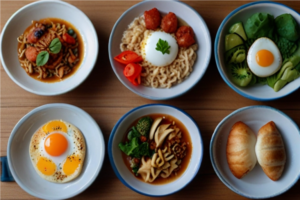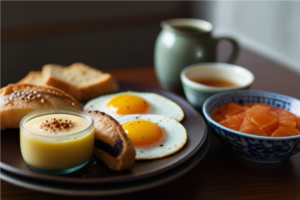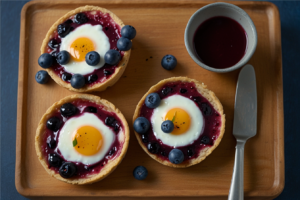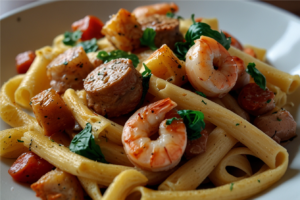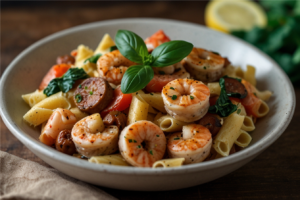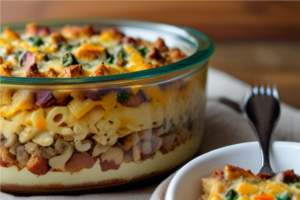
There’s nothing quite like waking up to the comforting aroma of a hot, ready-to-eat breakfast. Crockpot breakfast casserole recipes are the ultimate solution for stress-free mornings, offering a warm, nutritious, and satisfying meal that requires minimal effort. By harnessing the power of a crockpot, you can create a range of breakfast dishes that cater to various tastes and dietary preferences. In this comprehensive guide, we will explore different casserole recipes, provide tips for successful slow cooking, and answer common questions to ensure your mornings start off right. Let’s dive in and transform your breakfast routine!
Why Crockpot Breakfast Casseroles Are Ideal
Choosing a crockpot for breakfast preparation has numerous benefits. These casseroles are incredibly versatile, allowing you to experiment with a wide array of ingredients, from meats and cheeses to vegetables and even sweet options. The best part? You can set everything up the night before and wake up to a perfectly cooked meal. Whether you’re preparing for a busy day or hosting a brunch, a crockpot breakfast casserole is the perfect solution for a hearty start.
The Advantages of Slow Cooking
Slow cooking in a crockpot brings a unique set of advantages to breakfast preparation. Firstly, it allows flavors to develop and meld over time, creating a rich and robust taste. Secondly, the low temperature helps preserve nutrients, making crockpot cooking a healthier option compared to high-heat methods. Additionally, the crockpot reduces the need for constant monitoring, giving you the freedom to focus on other morning tasks while your breakfast cooks to perfection.
Understanding these benefits can help you appreciate why crockpot breakfast casseroles are a popular choice for so many households. With this in mind, let’s explore some classic recipes and creative variations to get you started.
Exploring Different Types of Crockpot Breakfast Casseroles
Crockpot breakfast casseroles come in a variety of styles, each with its unique ingredients and flavors. From savory to sweet, there’s something for everyone. Here’s a closer look at some of the most popular types of breakfast casseroles you can create with your crockpot.
Sausage and Egg Casseroles: A Classic Combination
Sausage and egg casseroles are a classic choice for a hearty breakfast. The combination of savory sausage, fluffy eggs, and melted cheese creates a rich and satisfying dish. To add variety, consider incorporating different types of sausage, such as spicy chorizo or mild breakfast links. Complement the flavors with diced onions, bell peppers, and a touch of herbs for an extra layer of complexity.
Vegetarian Breakfast Casseroles: Healthy and Flavorful
Vegetarian breakfast casseroles are a fantastic option for those seeking a lighter, plant-based breakfast. Ingredients like spinach, mushrooms, and tomatoes add color and nutrition, while cheese and eggs provide the protein. You can create a Mediterranean-inspired casserole with feta cheese and sun-dried tomatoes, or a southwestern-style dish with black beans, corn, and cilantro. These vegetarian options are not only delicious but also a great way to incorporate more vegetables into your morning meal.
Sweet Breakfast Casseroles: A Dessert-Like Treat
If you have a sweet tooth, you’ll love sweet breakfast casseroles. These recipes often feature ingredients like cinnamon, apples, and raisins, creating a warm and comforting dessert-like breakfast. You can also experiment with other sweet ingredients, such as bananas and chocolate chips, for a truly decadent treat. These sweet casseroles are perfect for special occasions or weekend brunches when you want to indulge.
With these different types of crockpot breakfast casseroles in mind, let’s explore some specific recipes that are sure to become favorites in your household.
Top Crockpot Breakfast Casserole Recipes
Ready to start cooking? Here are some delicious crockpot breakfast casserole recipes that will make your mornings delightful and stress-free.
Classic Sausage and Cheese Casserole
This recipe is a timeless favorite, featuring layers of crumbled sausage, cheddar cheese, and fluffy eggs. The addition of milk and seasonings ensures a creamy texture and robust flavor.
Ingredients
- 1 pound breakfast sausage
- 1 cup shredded cheddar cheese
- 8 large eggs
- 1/2 cup milk
- 1 onion, diced
- 1 bell pepper, diced
- Salt and pepper to taste
Instructions
- In a skillet, cook the sausage over medium heat until browned. Drain excess fat and set aside.
- In the crockpot, layer the cooked sausage, onion, bell pepper, and cheese.
- In a bowl, whisk together the eggs, milk, salt, and pepper.
- Pour the egg mixture over the layered ingredients in the crockpot.
- Cook on low for 6 to 8 hours, or until the eggs are set and the casserole is cooked through.
- Serve warm and enjoy your hearty breakfast.
Mediterranean Spinach and Feta Casserole
For a lighter breakfast with Mediterranean flavors, this casserole combines spinach, feta cheese, and sun-dried tomatoes.
Ingredients
- 1 package frozen spinach, thawed and drained
- 1/2 cup sun-dried tomatoes, chopped
- 1/2 cup crumbled feta cheese
- 8 large eggs
- 1/2 cup milk
- Salt and pepper to taste
Instructions
- In the crockpot, layer the spinach, sun-dried tomatoes, and feta cheese.
- In a bowl, whisk together the eggs, milk, salt, and pepper.
- Pour the egg mixture over the layered ingredients in the crockpot.
- Cook on low for 6 to 8 hours, or until the eggs are set and the casserole is cooked through.
- Serve with additional feta cheese and fresh herbs if desired.
Southwestern Breakfast Casserole with Chorizo and Black Beans
For a spicy and hearty breakfast, try this southwestern-inspired casserole featuring chorizo sausage and black beans.
Ingredients
- 1 pound chorizo sausage
- 1 can black beans, drained and rinsed
- 1 onion, diced
- 1 bell pepper, diced
- 1 cup shredded Monterey Jack cheese
- 8 large eggs
- 1/2 cup milk
- Salt and pepper to taste
Instructions
- In a skillet, cook the chorizo over medium heat until browned. Drain excess fat and set aside.
- In the crockpot, layer the black beans, chorizo, onion, bell pepper, and cheese.
- In a bowl, whisk together the eggs, milk, salt, and pepper.
- Pour the egg mixture over the layered ingredients in the crockpot.
- Cook on low for 6 to 8 hours, or until the eggs are set and the casserole is cooked through.
- Serve with salsa and fresh cilantro for extra flavor.
Sweet Apple Cinnamon Casserole
For a dessert-like breakfast, this sweet casserole combines apples, cinnamon, and brown sugar for a warm and comforting treat.
Ingredients
- 4 apples, peeled and diced
- 1/2 cup brown sugar
- 1 teaspoon ground cinnamon
- 8 large eggs
- 1/2 cup milk
- 1/4 cup butter, melted
Instructions
- In the crockpot, layer the diced apples, brown sugar, and cinnamon.
- In a bowl, whisk together the eggs, milk, and melted butter.
- Pour the egg mixture over the layered ingredients in the crockpot.
- Cook on low for 6 to 8 hours, or until the eggs are set and the casserole is cooked through.
- Serve warm with a dollop of whipped cream or a drizzle of maple syrup for a delightful morning treat.
Tips for Successful Crockpot Breakfast Casseroles
Creating the perfect crockpot breakfast casserole requires a bit of preparation and attention to detail. Here are some tips to ensure your casseroles turn out great every time:
Layer Ingredients Strategically
When layering your ingredients in the crockpot, start with the driest and densest components, like potatoes or bread, at the bottom. This helps absorb any excess moisture and prevents the casserole from becoming soggy.
Don’t Overfill the Crockpot
Avoid overloading the crockpot, as this can lead to uneven cooking and longer cook times. Make sure there’s enough space for the ingredients to cook evenly and for steam to escape.
Choose the Right Cooking Time
Most crockpot breakfast casseroles require 6 to 8 hours on low heat. If you need the casserole to be ready in a shorter time, you can use the high setting, but keep a close eye on it to prevent overcooking. Generally, the low setting is best for overnight cooking.
Add Cheese Near the End
If your casserole includes cheese, consider adding it during the last 30 minutes of cooking. This allows the cheese to melt without becoming overly crispy or burnt.
Prepare Ingredients the Night Before
To make mornings even easier, prepare all your ingredients the night before. You can chop vegetables, cook meats, and mix the egg base in advance. This way, all you need to do is assemble and start the crockpot in the morning.
With these tips in mind, you’re well on your way to creating delicious and hassle-free crockpot breakfast casseroles. Now, let’s address some common questions to ensure you’re fully equipped for success.
Frequently Asked Questions About Crockpot Breakfast Casseroles
Can I Prepare My Crockpot Breakfast Casserole the Night Before?
Yes, you can prepare your crockpot breakfast casserole the night before. Simply layer the ingredients in the crockpot, cover, and refrigerate until you’re ready to start cooking. This is a great way to save time in the morning and ensures the flavors meld beautifully overnight.
How Can I Prevent My Crockpot Breakfast Casserole from Becoming Soggy?
To prevent a soggy casserole, ensure you have a solid base of dry ingredients like potatoes or bread. Avoid adding too much liquid, and allow the casserole to rest for a few minutes after cooking to let excess moisture evaporate. Also, consider using a vented crockpot lid or propping the lid slightly open to allow steam to escape.
Is It Safe to Leave My Crockpot On Overnight?
Yes, it’s generally safe to leave your crockpot on overnight, especially when using the low setting. Just ensure your crockpot is in good working condition and placed on a stable, heat-resistant surface. If you’re concerned about safety, consider using a crockpot with a built-in timer that automatically switches to a warm setting after the cooking time is complete.
Can I Freeze Leftover Crockpot Breakfast Casserole?
Yes, you can freeze leftover breakfast casserole for later use. Cut the casserole into portions and wrap them tightly in plastic wrap or aluminum foil. Place the wrapped portions in a freezer-safe bag or container. To reheat, thaw the portions in the refrigerator overnight and reheat in the oven or microwave until heated through.
What Are the Best Ingredients for a Healthy Crockpot Breakfast Casserole?
To create a healthier breakfast casserole, consider using lean proteins like turkey sausage, adding plenty of vegetables, and using low-fat dairy options. You can also incorporate whole grains or nutrient-dense carbohydrates like sweet potatoes for added fiber and vitamins.
With these FAQs addressed, you’re now ready to embrace the world of crockpot breakfast casseroles. From classic recipes to creative variations, the possibilities are endless. So, go ahead and start planning your next breakfast adventure with the crockpot as your trusty kitchen companion.
